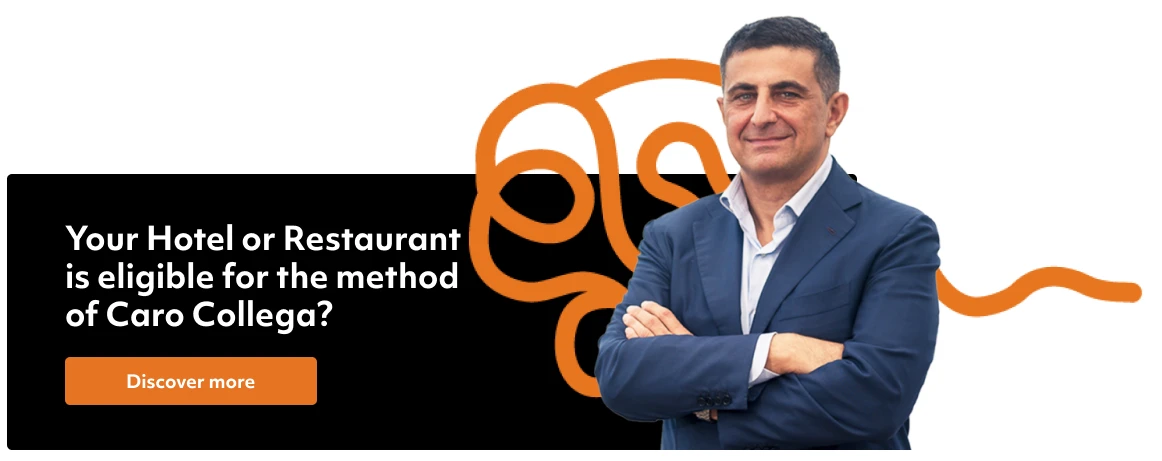In an increasingly digital world, having a performing website is essential for the success of your Restaurant or Hotel. The reason is simple: when you need to search for a Hotel or Restaurant, what do you do?
I am Giancarlo De Leonardo, former Hotelier and Restaurateur, founder of Caro Collega, a club of enlightened entrepreneurs fighting for the digital empowerment of the hospitality industry.
That is, they want to understand how to generate extra revenue through the opportunities that the digital revolution offers in the hospitality industry, as well.
If you are tired of relying on Word of Mouth or if you are tired of making a living from the customers that Booking.com or TheFork or similar tools send you, this article is a starting point toward the process of digital enlightenment. A process I know very well because it has affected me too, given the fact that after more than 20 years as a manager and entrepreneur in the industry, I am now involved in digital marketing. Translated into “ospitalese” the language I understood best when I was in this business, together with a Digital Dream Team I generate extra revenue in a modern and sustainable way, including for Hotels and Restaurants.
This article takes its cue from one of the biggest mistakes I made when I was a hotelier and restaurateur: underestimating everything I didn’t know! And one of those mistakes was about the website, that is, your digital home, which needs to be taken care of in detail for 2 reasons:
- So that the algorithm understands what your business offers and who are the most suitable customers for your business. The more information you offer the algorithms, the more they will know about your business and prefer to send customers to you rather than to your competitors.
- So that you become a “customer catcher” tool because it is the website where the conversion process begins, leading a potential customer to become a booking customer.
In this article
Why Google’s algorithm prefers one website over another
At the heart of Google’s design is one thing: user satisfaction. Google is the engine that collects more than 70% of user queries because it is the one that offers the best answers. And to offer the best answers, it must understand what your business offers and present itself to interested users with up-to-date information.
For this reason, the world’s most widely used search engine has for more than 2 years introduced a set of metrics called “Core Web Vitals” that evaluate the user experience offered by a website. Core Web Vitals in fact measure parameters such as page loading speed, visual stability, and interactivity.
The more reliable these parameters are deemed to be, the more engaging the user experience will be: in practice, Google receives requests from users (e.g., kosher restaurant or hotel with spa), decides which website to bookmark and judges by the “bounce rate” of users whether or not the answers it provided are liked or disliked.
Appreciation or disapproval from users determines its ranking in search results. And liking depends on relevance and user experience, if they find it difficult to find the information they are looking for, they will inevitably abandon your website!
As a matter of fact, you know that placing a Hotel or Restaurant in the top positions of the Google page can determine the success or otherwise of a business.
Core Web Vitals
What are the most important Core Web Vitals for building a website that meets the demands of the user searching for your restaurant or hotel?
- Loading Speed: Modern users are increasingly impatient and want to get the information they need as quickly as possible. Creating a restaurant or hotel website that loads pages quickly is critical to keeping users’ attention and preventing site abandonment. That’s why Core Web Vitals measure page loading speed, promoting websites that offer a fast and smooth browsing experience.
- Visual stability: visual instability (images that flicker or do not load properly) can cause users frustration when browsing the website. When page elements move or load late, it can be difficult for users to interact with the desired content. Core Web Vitals reward visual stability so that websites are pleasant to navigate and do not cause problems for users.
- Interactivity: users want an interactive and responsive browsing experience. If a website takes a long time to respond to user commands, such as clicking a button or filling out a form, users may feel discouraged and abandon the site. Core Web Vitals focus on website interactivity, rewarding those that respond quickly to user actions.
Best Practices
Based on the websites developed over the past 2 years by Caro Collega for Hotels and Restaurants, here are some suggestions:
- Choosing an experienced website team: hire a team of professionals who have experience in building high-performing websites that are optimized for Core Web Vitals. Choosing the right partner can make all the difference in the quality and performance of your website. Caro Collega’s Digital Dream Team dedicated to website development consists of a project manager, a web designer, a developer, an SEO expert, and a copywriter. Not one person then, but a collection of vertical people on each individual task.
- Image optimization: reduce image sizes and use compressed formats to improve page load times. Image optimization can significantly help improve the overall speed of your website.
- Browser cache: use browser caching to allow users to temporarily store data from your website, thus reducing load times on subsequent visits. Properly configure your site’s cache to optimize the user experience.
- Code minimization: minimize unnecessary HTML and JavaScript code to optimize your website’s performance. Remove whitespace, comments, and redundant code to ensure faster loading of pages.
- Reliable hosting: make sure you use a reliable hosting service that offers speed and reliability for your website. Low-quality hosting can slow down site performance. Carefully evaluate your hosting options and choose a solution that meets the needs of your site.
- Responsive website: make sure your website is fully optimized for mobile devices. Ninety percent of users access the Internet via smartphones or tablets, so it is critical to provide a smooth and responsive browsing experience on all platforms. Responsive design is a key factor in improving usability and user experience.
- Constant monitoring and optimization: use tools such as Google Analytics, Google Search Console, the Tag Manager and Google Ads to monitor your website’s performance, identify any problems and make ongoing improvements. These tools will provide you with valuable information about your site’s performance and user behavior, enabling you to make the data-driven decisions that are the ones that will generate that extra revenue that will improve your Hotel or Restaurant’s performance.
Conclusions
Creating a high-performing website that meets Core Web Vitals and keeping it constantly updated and monitored through Google tools will allow you to provide an experience that will please users and consequently improve your hotel or restaurant’s online visibility and increase the number of visitors and potential customers.
Do not overlook the importance of a high-performing and optimized website: it is the digital home of your business and it can become a great tool for creating a strong online presence and attracting new customers.
Finally, you can always monitor the performance of your website thanks to Google PageSpeed, which is one of the free tools provided by Google to evaluate the performance of your website.
Article written by Giancarlo De Leonardo, former restaurateur and hotelier, founder of Caro Collega

